
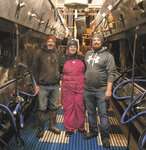
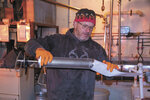

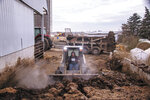
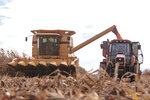
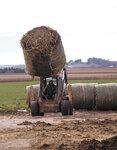
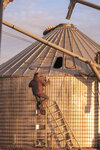
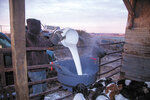
EARLVILLE, Iowa — Dennis Burkle did not know if his daughter Mindy would return to the farm after college, but she knew she would. Now they share the duties of dairy farming every day.
“It’s in my blood,” Mindy said. “I went off to college and missed the cows. I ended up coming back, and one thing led to another. I started buying cows, and now, here I am.”
Dennis and Mindy work together to manage the cows. Dennis’s wife, Sherry takes care of the bookwork and helps as needed. The Burkles milk 140 cows and farm 450 acres near Earlville. Mindy does all the A.I., and Dennis is in charge of the crops. Most of the cattle are Holstein or Holstein-Brown Swiss crossbreds, and Mindy owns a small herd of 15 registered Brown Swiss.
“We had a Brown Swiss breeding bull when I was growing up, and I fell in love with the crossbreds,” Mindy said. “When I came back to the farm, I wanted some full-bred Brown Swiss of my own.”
Similar to many other areas across the U.S., the number of farms in the Burkles’ area is consistently decreasing.
“I worked with a lot of my previous dairy farming neighbors in the area on harvest,” Dennis said. “There is just a fraction of dairy farms left. If this job was easy, everyone would do it.”
The remaining dairy farmers in Delaware County try to help each other whenever they can.
“We have pretty good neighbors around here,” Dennis said “Usually, if someone has a piece of equipment, you can rent it or trade pieces of equipment to help each other get things done. It works out well.”
Fall is a busy time of year for all farmers with harvesting crops, hauling manure and tillage on top of the daily chores of milking and feeding cows.
On Nov. 1, Dennis and Mindy started their day at 5 a.m. with milking their cows in their double-11 parallel parlor.
“I will be in the parlor milking, and Dad will be in the freestall scraping up,” Mindy said. “I will breed any cows that need to be bred after morning or evening milking.”
Dennis used the skid loader to scrape in the sawdust-bedded freestall barn. Then he fed the calves, which are housed in pens holding eight to 10 calves each and fed by mob feeders.
Next, Dennis made his way to the compost barn and turned the compost. The barn houses cows under 100 days in milk, Mindy’s Brown Swiss and a few cows that do not like the freestall barn.
“I have a little tiller on the back of a little tractor that turns the sawdust over in the compost barn,” Dennis said.
From there, Dennis went to mix his total mixed ration to be fed in the next 24 hours. The ration for the lactating cows consists of ground high-moisture corn, roasted soybeans, dry hay, and a custom supplement mix with cottonseed, corn silage and haylage.
Once the daily chores were finished, the Burkles headed to the field. They had completed most of the harvest and were putting the last of their corn in the dryer bin to dry down completely before being transferred into a regular grain bin for storage.
“We only did 10 acres that day,” Dennis said. “With our drying capacity, 13 or 14 acres is all we can take in at a time; then the bin is full. We have to wait for it to dry down and then transfer it to another bin.”
They had taken in all they needed for corn silage and had another 40 acres left to fill their grain bins and eventually sell.
“The cash crop corn we are taking in now is just extra income, which makes up less than 10% of our income but still comes in handy,” Dennis said.
The corn on average yielded from 205 to 235 bushels per acre for the Burkles this year.
“I don’t know what the corn survived on this summer because we didn’t get much for rain,” Dennis said.
The Burkles already harvested all 50 acres of soybeans that they planted and will have it roasted to add to the ration for their lactating cows. Dennis said their soybeans also did well — on average yielding 65 bushels per acre — considering the lack of rain.
While Dennis was combining corn, Mindy scraped up the pens and hauled manure.
“We haul most of our own liquid manure,” Dennis said. “Two sites are right next to each other, and the third is 3.5 miles away. That one we haul to in the fall because it takes 30 minutes to get there.”
Dennis and Mindy dairy farm, they said, because they enjoy it.
“My favorite part is going to the store and seeing someone go to the cooler and take a couple gallons of milk with your creamery’s name on it,” Dennis said. “Seeing the calves go from their first feeding to their first calf in 24 months — it’s almost the same feeling seeing your kids growing up.
Mindy agreed.
“I enjoy watching my own little herd grow,” she said. “I am working to improve my genetics.”
Comments
No comments on this item Please log in to comment by clicking here